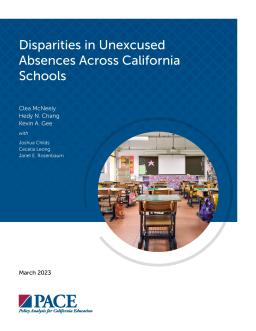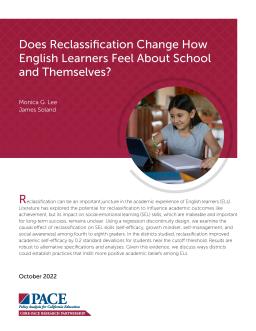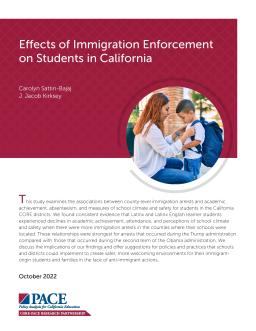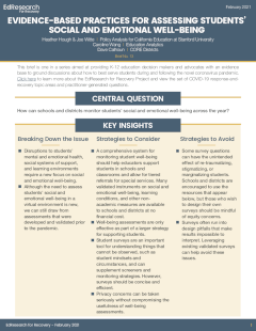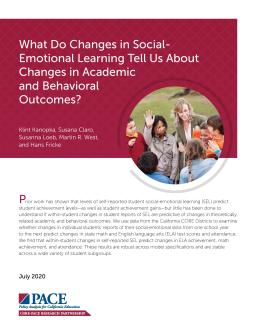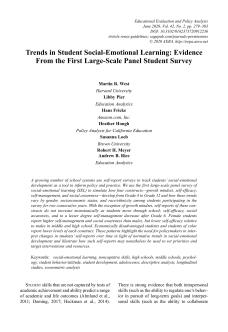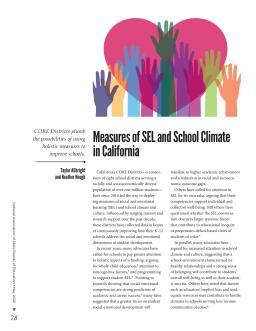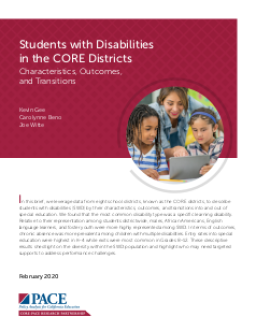Published
Summary
This report finds that improving school attendance is crucial, especially with the increase in chronic absence. Data on unexcused absences should be used to create a more preventive, problem-solving, and equitable response to poor attendance. Labeling absences as unexcused affects how students and families are treated and can lead to punitive measures that may not improve attendance. Overuse of the unexcused-absence label could undermine efforts to partner with students and families to improve attendance.
Published
Summary
This study explores the impact of reclassification on social-emotional learning skills (SEL) of English learners (ELs) in grades 4 to 8. Using a regression discontinuity design, the study found that reclassification improved academic self-efficacy by 0.2 standard deviations for students near the cutoff threshold. The results suggest that reclassification can positively influence the academic beliefs of ELs and the authors provide recommendations for districts to create practices that foster such positive beliefs.
Published
Summary
This study explores the impact of county-level immigration arrests on the academic achievement, attendance, and perceptions of school climate and safety for Latinx and Latinx English learner students in California's CORE districts. The research found that there is a negative relationship between immigration arrests and these students' academic performance and school experiences. The study recommends policies and practices that can help schools and districts create safer, more welcoming environments for immigrant-origin students and families in the face of anti-immigrant actions.
The Impact of Unmotivated Questionnaire Responding on Data Quality
Published
Summary
This article explores the issue of satisficing, which is suboptimal responding on surveys, in the context of a large-scale social-emotional learning survey administered to over 400,000 elementary and secondary students. Despite concerns about its impact on data quality, the study found that satisficing had a more modest effect than expected. The article offers an approach for defining and calculating satisficing for researchers, practitioners, and policymakers to improve the quality of survey data.
Evidence from the CORE Districts
Published
Summary
The CORE Districts in California conducted a survey to measure K-12 students’ social-emotional well-being during the pandemic. Results indicate that students’ personal and interpersonal well-being rated lower than their learning environments. Interpersonal well-being was most correlated with academic achievement. Home/online learning environment improved, but Grades 5-12 students reported not liking school as much in winter 2020-21. Stakeholders should focus on meeting the pressing needs of each group of students.
Published
Summary
This brief is one in a series aimed at providing K-12 education decision makers and advocates with an evidence base to ground discussions about how to best serve students during and following the novel coronavirus pandemic. Learn more about the EdResearch for Recovery Project and view the set of COVID-19 response-and-recovery topic areas and practitioner-generated questions here. The central question of this brief is: How can schools and districts monitor students’ social and emotional well-being across the year?
Published
Summary
This article assesses confusion due to negative wording on social-emotional learning (SEL) assessments using mixture IRT models. Results based on student self-reports show confusion biasing scores, especially in Grades 3-5, and correlational relationships between SEL constructs and reading proficiency and ELL status. Using positively oriented items in future SEL measures is recommended to address these issues.
Published
Summary
This study used data from California CORE Districts to explore whether changes in students' self-reported social-emotional learning (SEL) predicted changes in academic outcomes and attendance. The findings revealed that within-student changes in SEL were positively associated with improvements in English language arts (ELA) and math achievement, as well as attendance, and were consistent across various student subgroups.
Evidence From the First Large-Scale Panel Student Survey
Published
Summary
Self-report surveys are used to track students’ social-emotional development. This large-scale panel survey reveals that self-efficacy, social awareness, and self-management decrease after Grade 6, except for growth mindset. Female students report higher self-management and social awareness but lower self-efficacy than males in middle and high school. Students of color and economically disadvantaged students report lower levels of each construct. Policymakers should consider these trends and use self-reports to target interventions and resources.
Published
Summary
California's CORE districts have been collecting data since 2014 on social and emotional learning (SEL) and school climate and culture to improve K-12 schools' holistic approach to student development. Advocates argue that a focus on SEL and school culture will lead to higher academic achievement and better well-being for students. The CORE districts developed survey instruments for SEL competencies and school climate perceptions involving students, staff, and parents. Many states and districts have adopted SEL-specific curricula and disciplinary reforms.
Characteristics, Outcomes, and Transitions
Published
Summary
The CORE districts studied characteristics, outcomes, and transitions of students with disabilities (SWDs). Specific learning disability was the most common type. Males, African Americans, English learners, and foster youth were overrepresented. Chronic absence was higher for SWDs with multiple disabilities. Most SWDs entered special education in K-4 and exited in grades 8-12. These results help identify who may need targeted support.
